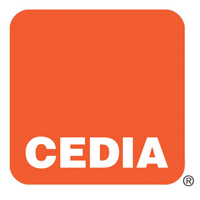
|
|
Contributed by the Custom Electronic Design & Installation Association. To learn more about CEDIA membership visit www.cedia.org/join. |
I’m guessing you’ve heard the terms Ultra HD and 4K by now. Coming out of CES 2013, the buzz about these new ultra high-resolution video formats has been inescapable. With major display manufacturers championing UHD as the greatest thing since the invention of the motion picture, it is tough to separate the technophile specs that we all love to geek out on from the real-world applications. To evaluate how these new video technologies will impact the market, we must first decipher the alphabet soup of format names and understand their relationship to each other.
“Ultra HD” is the new moniker set forth by the CEA Ultra HD Working Group to encompass all of the various formats for resolutions above Full HD (1920 x 1080, which is approximately 2 megapixels). In order for a display to meet the minimum requirement to be considered UHD, it must have twice the vertical and horizontal resolution of Full HD, which translates to 3840 x 2160 (over 8 million individual pixels), and an aspect ratio of at least 16/9 (1.78:1). This particular format was formerly known as (and still may be referred to as) “Quad HD” because it effectively carries a resolution equivalent to four full HD pictures. It is important to note that while it does contain four times the number of total pixels as Full HD, it only doubles the vertical resolution, which is the more critical aspect when it comes to a person’s perception of detail.
The term “4K” is probably the one best known within the industry and has been used to describe a variety of different resolution formats. However, the correct specification for 4K comes from the commercial world and our friends in digital cinema. A true 4K picture (sometimes called 4K x 2K) has a resolution of 4096 x 2160, which amounts to an aspect ratio of approximately 17/9 or 1.89:1 (a ratio commonly used for widescreen films). Again, do not be misled when comparing 4K to Full HD. It is very common for people to measure the resolution of Full HD using the vertical plane by calling it 1080p and contrast it with 4K, which is actually a reference to the horizontal resolution. Like UHD, 4K’s resolution is equal to double the vertical resolution of Full HD.
How These New Formats Affect Viewing
So what does it all mean? Perception of detail is affected by three factors. We have already discussed one of them (resolution), so now let’s dive into the other two: display size and viewing distance.
It is relatively easy to understand how these factors affect a person’s perception of image detail. For viewing distance, the closer they are to an object, the more detail they can see; while the farther away they are, the less detail. The same is true for display size — one can see more detail in larger objects than in smaller objects. So adding more resolution to displays allows for one of two changes in a viewing environment, while maintaining the same perception of detail, shorter viewing distances or larger screen sizes.
UHD and 4K resolutions are going to be a major factor in pushing screen sizes to larger and larger dimensions. Right now, these technologies are considered to be “bleeding edge” and will carry a hefty price tag. There is very little content currently available in UHD resolutions.
In the end, these new formats are simply the next step in the evolution of display devices. It is now up to us as experts to educate our clients about the new technology and then specify and implement it correctly.
A free webinar, “4K and the Future of Home Theater,” is available from CEDIA at www.cedia.net/elearning. CEDIA also will release a white paper on 4K later this year. Stay tuned for details by signing up for the CEDIA weekly newsletter by visiting www.cedia.net/blog and clicking “join our mailing list” on the right-hand side of the page.
The aforementioned conversation that has to occur between devices is actually called the HDMI initialization sequence (commonly called “handshake”) and the first step in this sequence is known as “Hot Plug.” Hot Plug is a +5v signal sent between the source and display, acknowledging that they are connected to each other. This is the wakeup call telling both devices to begin sharing information. If the +5v Hot Plug pulse does not occur, or attenuates to the point of being below the threshold voltage, then you basically get nothing. Game over — go directly to troubleshooting; do not pass go, do not collect picture or audio.
The second step in the initialization sequence is known as the Extended Display Identification Data (EDID) standard. It was originally developed by the Video Electronics Standards Association (VESA) to support plug-and-play functionality within the computer community. The idea is that by having a display share its formatting/processing capabilities with the source, a consumer would always experience the highest-quality video and audio within the system’s capabilities. While fantastic in theory, manufacturers have struggled somewhat with implementing EDID correctly across all products since its adoption within the consumer electronics space. Because a display’s EDID is responsible for instructing the source on how to format and send the A/V information, incorrect communication may cause all sorts of seemingly odd anomalies — stereo instead of multi-channel audio, wrong aspect ratios, incorrect colorimetry, lower-than-optimal resolutions, or even no video/audio at all. It is important to note that the complexities of EDID processing increase exponentially when using HDMI splitters or matrix switches connected to multiple displays with differing EDIDs.
The final step in the “handshake” process is copyright authentication, also known as High-Bandwidth Digital Content Protection (HDCP). I have often heard it affectionately referred to within the industry as “Hollywood’s Defense against Chinese Piracy.” HDCP was developed by Intel as a copy-protection scheme requiring key exchanges between authorized devices before allowing content to be viewed. While this may seem perfectly reasonable and easy to execute on the surface, there are multiple factors that contribute to authentication failures within a significant number of HDMI systems.
First, even though HDMI v1.0 was officially launched in 2003, no HDCP compliance testing specifications existed until 2006. Second, the HDMI specification allows for up to 127 different “key” values per device; yet, many manufacturers assume their source device will be connected to only one display, and therefore implement a measly one to three keys. This can be a major problem if you are sending the signal from that source to multiple destinations. Unless the splitter/matrix switch you’re using has the ability to monitor and enforce HDCP compliance internally, when more displays are connected than there are keys for the source to hand out, you will typically end up with either the “flashing screen of death” or a beautiful image of the environment described by Edgar Allen Poe in the “Pit and the Pendulum.” Lastly, it is possible for manufacturers to issue firmware updates affecting the way HDCP is handled by their devices and these updates can break a system of devices that were previously working together quite well.
While this exercise of peeling back the jacket to expose the internal workings of HDMI may not have been quite as exciting as watching an everyday object transform itself into a walking, talking, superhero robot, hopefully it has given you some ideas about how to be successful when dealing with the complexities of today’s most popular digital video transmission medium. Armed with this knowledge (which is almost as cool as being armed with a plasma cannon, right?), it is now your job to go out and provide your clients with systems of the highest quality and reliability.
To learn more, check out the CEDIA Marketplace online or use the CEDIA app on your smartphone to find our white paper series on HDMI. Be sure to keep an eye on the CEDIA calendar of events for in-person and hands-on training sessions, including the Home Theater Boot Camp and HDMI Workshop.




